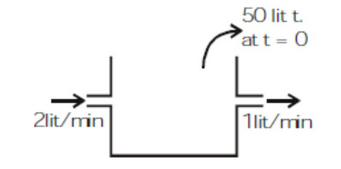Differential Equations - Class 12 Commerce Applied Mathematics - Extra Questions
If y=Aemx+Benx, show that d2ydx2−(m+n)dydx+mny=0.
Solve: (1+y2)dx+(x−e−tan−1y)dy=0,y(0)=0
Integrating factor of xdydx−y=x4−3x is:
The volume of a sphere is increasing at the rate of 3 cubic centimetre per second. Find the rate of its surface area, when the radius is 2cm.
The differential equation of parabola with axis parallel to y-axis and length of latus rectum as 4a is of order:
Find the integrating factor of the differential equation (e−2√x√x−y√x)dxdy=1.
The rate at which the population of a city increases at any time is proportional to the population at that time. If there are 1,30,000 people in the city in 1960 and 1,60,000 in 1990, what approximate population may be anticipated in 2020?
[loge1613=0.2070,e0.42=1.52]
If the population of a country doubles in 60 years, in how many years will it be triple under the assumption that the rate of increase is proportional to the number of inhabitants?
[Given: log2=0.6912 and log3=1.0986.]
The solution of dydx=xlogx2+xsiny+ycosy is
Solve 2yexydx+(y−2xexy)dy=0
Solve dydx=xcosx
The population of a city increases at a rate proportional to the number of inhabitants present at any time t. If the population of the city was 200000 in 1990 and 250000 in 2000, what will be the population in 2010?
Represent the following families of curves by forming the corresponding differential equation.(a, b being parameters).
y2=4ax.
The population of a city increases at a rate proportional to the number of inhabitants present at any time t. If the population of the city was 200000 in 1990 and 250000 in 2000, what will be the population in 2010?
Let f:R→R be a continuous function which satisfies f(x)=∫x0f(t)dt Then the value of f(ln5) is
A function y=f(x) satisfying f"(x)=x−3/2,f′(4)=2 and f(0)=0 is −λ√x+3x, then find the value of λ
The largest value of 2πc such that there exists a differentiable function h(x) for −c<x<c that is a solution of y′=1+y2 with h(0)=0 is:
A tank consists of 50 liters of fresh water. Two liters of brine each litre containing 5 gms of dissolved salt are running into tank per minute ; the mixture is kept uniform by stirring , and runs out at the rate of one litre per minute.If m grams of salt are present in the tank after t minute. expression of m in terms of t bem=kt(r+2p+tp+t)gm. Find (p/k)+r ?
Let (x2+1)d2ydx2=2xdydx, where y′(0)=3 & y(0)=1, then y(1) is equal to:
Find the particular solution of the following differential equation;
(x + 1)\dfrac {dy}{x} = 2e^{-y} - 1; y = 0 when x = 0
Find the particular solution of the following differential equation:
(x+1)\dfrac{dy}{dx} = 2e^{-y} - 1, given that y = 0 when x = 0.
The temperature T of a cooling object drops at a rate proportional to the difference (T - S), where S is constant temperature of surrounding medium. If initially T = 150^{\circ}C, find the temperature of the cooling object at any time 't'.
The sum of Rs. 1000 is compounded continuously, the nominal rate of interest being four percent per annum. In how many years will the amount be twice the original principal? (\log_e2 = 0.6931).
A radioactive substance disintegrates at a rate proportional to its mass. When its mass is 10 mg, the rate of disintegration is 0.051 mg per day. How long will it take for the mass to be reduced from 10 mg to 5 mg? \left( \log _{ 2 }{ 2 } =0.6931 \right) .
A body is heated at 110^{\circ}C and placed in air at 10^{\circ}C. After 1 hour its temperature is 60^{\circ}C. How much additional time is required for it to cool to 35^{\circ}C?
The population of a town grows at the rate of 10\% per year. Using differential equation, find how long will it take for the population to grow 4 times.
The rate of growth of population is proportional to the number present. If the population doubled in the last 25 years and the present population is 1 lac, when will the city have population 4,00,000 ?
(x^{2} + y^{2}) dy = xy dx. If y(1) and y(x_{0})= e then find the value of x_{0}.
Class 12 Commerce Applied Mathematics Extra Questions
- Application Of Derivatives Extra Questions
- Applications Of Integrals Extra Questions
- Definite Integrals Extra Questions
- Determinants Extra Questions
- Differential Equations Extra Questions
- Indefinite Integrals Extra Questions
- Linear Equations Extra Questions
- Matrices Extra Questions
- Probability Distribution And Its Mean And Variance Extra Questions
- Quantification And Numerical Applications Extra Questions
- Standard Probability Distributions Extra Questions
